I've spent more than 100 hours riding the rails in the US and Europe. Here are 8 differences I noticed between train travel in each place.
Joey Hadden

- I've taken Amtrak trains around the US — from business class to sleeper cabins.
- I also recently spent two weeks traveling by train in Europe for the first time, in various classes.
I've traveled by train in the US and Europe, in coach, business, and first class, along with private and shared sleeper cabins. I've noticed many key differences between rail services in each place, from booking to the ride itself.
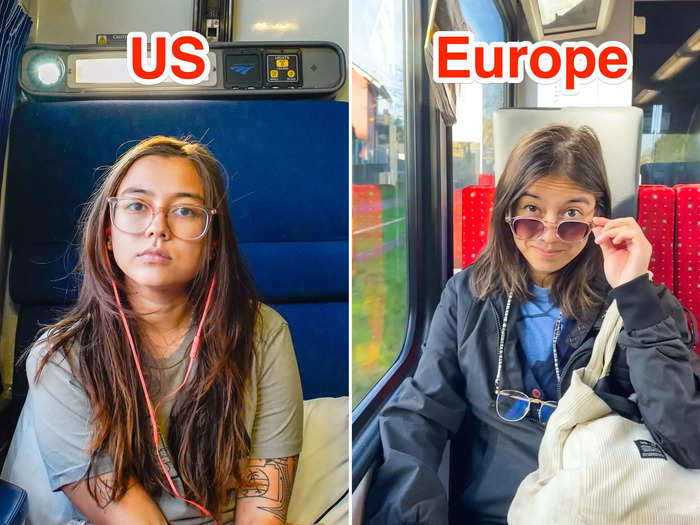
If you tallied all the hours I've collectively spent on trains, it would add up to multiple days.
I've taken local coach trains in the US throughout my life. And nearly a year and a half ago, I started taking long-haul train trips up and down the East Coast, trying out upgraded accommodations from business and first class to private sleeper cabins.
In October 2021, I spent a total of 60 hours on overnight Amtrak trains between NYC and Miami in Amtrak sleeper accommodations, including roomette and bedrooms.
Then, in February 2022, I rode in first and business class on Amtrak Acela trains between NYC and Baltimore. And in August, I spent 10 more hours in Amtrak's business class from NYC to Niagara Falls, New York.
By October 2022, I was ready to experience something different: train travel in Europe. I traveled by train through four European countries over the course of two weeks — Germany, Austria, Italy, and Switzerland — trying out classes on multiple different lines, including OBB Nightjet, Trenitalia, and InterCity Express, from coach to first class, and sleeper cabins.
During my travels, I learned that train travel in Europe and the US is not the same. Here are the most important differences I learned that I think all US train travelers should know before riding the rails.
In the US, I've always purchased one individual train ticket per ride. But in Europe, I bought one train pass that allowed me to ride four trains without an additional fee, and overnight trains with a small, discounted surcharge.

The differences between train travel in the US and Europe for me began with the booking process.
When booking train tickets in the US on Amtrak, I've always purchased individual tickets for each ride.
But in Europe, I learned I could buy a Eurail pass that would grant access to most European trains for a set number of days. Some trains only require a Eurail pass, while others, including overnight trains, incur an additional discounted price.
For my European train trip, I bought a week-long Eurail pass for $477. The pass allowed unlimited rides on most trains over a seven-day period, which typically cost me between $60 and $100 each in the US.
I only had to pay additional fees on top of my Eurail pass when I took overnight trains, or if I wanted to upgrade from coach to first and business class. Each added fee was between $10 and $45, depending on the duration of the trip.
In the US, boarding trains is easy and straightforward. But in Europe, I found the process to be more confusing as I had to board a specific car to ensure I'd reach my final destination.
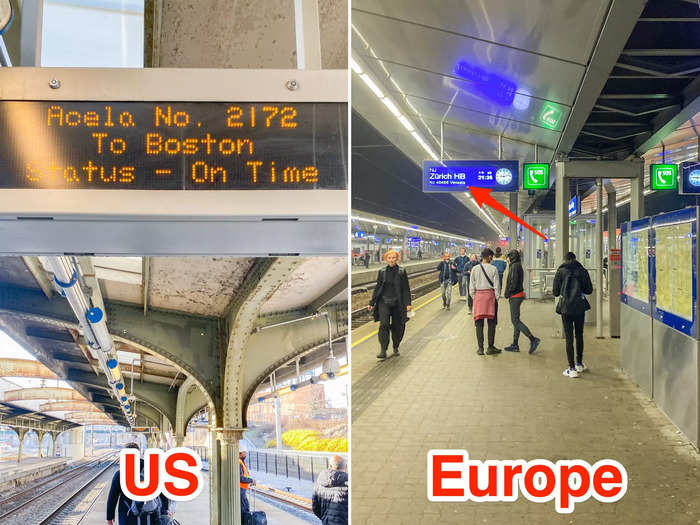
Whenever it's time to board a train, information screens on the platforms help ensure that I am in the right place.
Before traveling by train in Europe, every information screen I'd seen on a platform in the US showed one final destination for the ride. For example, when I traveled from Baltimore to NYC, I knew my train's final destination was Boston, and New York was a stop along the way, so I felt secure when I arrived on the platform and a screen said that's where my train was headed.
But when I got to Europe, the platform screen didn't directly match up with my destination on Nightjet trains. For example, when I arrived at the station for an overnight train from Austria to Italy, the departure screens said my train, listed by number, was going to Switzerland.
I went to the information desk and learned that, unlike my Amtrak experiences, some of the train's cars detach at various stations to go to different locations. I'd need to board my assigned train car to make sure I was on a car heading to, in my case, Italy. The way to determine this was by looking for a train car's exact number.
I thought this made the boarding process more stressful since I couldn't enter any car like I would in the US. If I got in the wrong car, I'd end up in the wrong country.
In my opinion, seats on European trains were more comfortable than those I've experienced in the US.
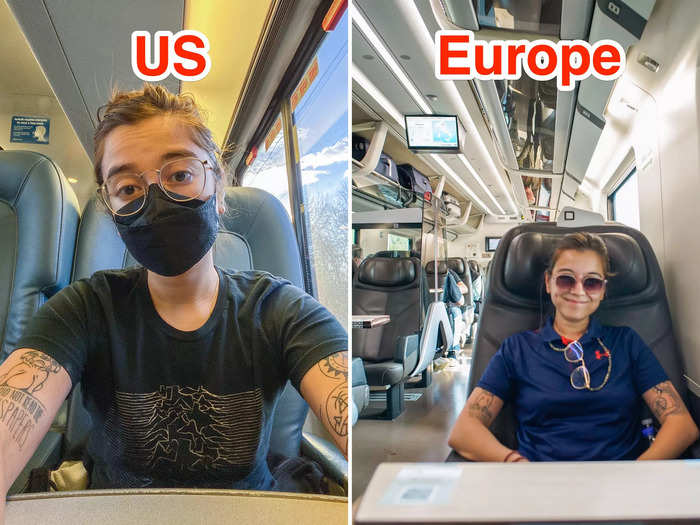
In my experience, European trains seem to prioritize comfort more than I've found on US trains.
When traveling in coach on Amtrak trains, I expect to feel slightly uncomfortable since the chairs are less spacious than in other classes. But in first and business class on Amtrak trains, I remember thinking that the chairs appeared to be big, and so I expected them to be comfy and plush. However, once I sat down, they felt stiffer than I thought they would be.
This was not the case for me in Europe. From coach to first and business class on Trenitalia trains, I thought my European train seats were much softer than those I've experienced in the US, making it easier to sit for long periods of time.
European train seats I rode on also had winged headrests, which I have not experienced on trains in the US, and I thought they made it easier to relax than on Amtrak trains that lacked them.
In the US, I've only seen personal trash cans inside private sleeper cabins. But in Europe, I noticed that first and business-class seats had them at each seat.
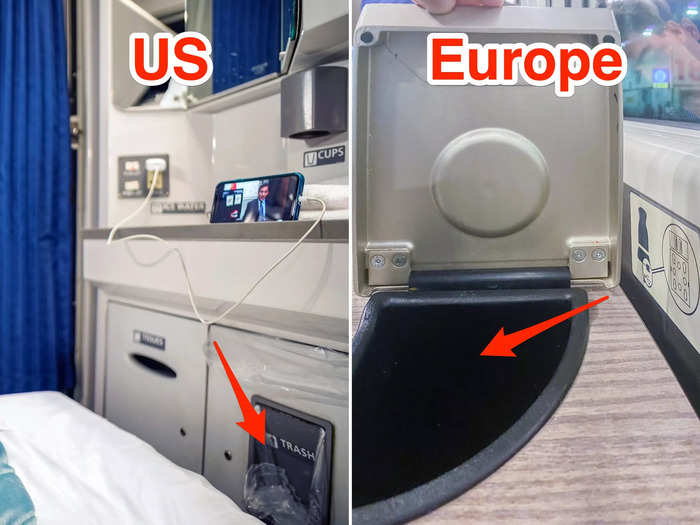
From gum wrappers to empty bags of chips, I find that trash tends to accumulate on long-haul train rides.
When I've traveled by train in the US on Amtrak in coach, business, or first class, I usually have to hold only my garbage until I'm ready to bring it all to a large, shared can at the end of the train car. Only when I've booked private sleeper cabins such as roomette or bedroom accommodations on Amtrak did I have my own trash can to use as I needed.
So in Europe, I was surprised to find my own personal trash can at my seats on business and first-class Trenitalia train cars. Between the tables and the window on these trains, there was a small trash can at each seat that was large enough to contain all of my garbage from each trip. I thought this made it easier to get rid of waste from snacks, drinks, and meals quickly without having to get up every time.
I also noticed that, unlike US trains I've taken, European trains typically have high-tech touches like touchless doors and information screens to preview upcoming stops and a map of the route.
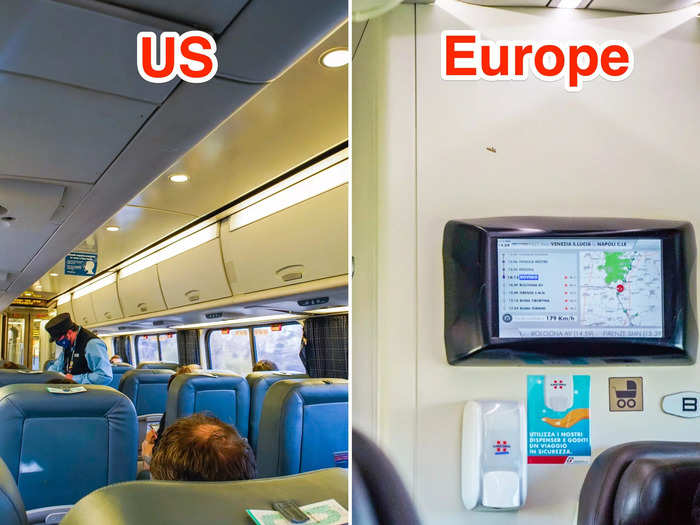
When traveling by train, I think it's important to know where I am and where I'm headed at all times to make sure I don't miss my stop.
On Amtrak trains in the US, I've heard announcements about forthcoming stops made over the intercom, but other than that, I've had to use my phone's GPS to track where I was on the route.
In Europe, I thought trains provided clearer communication on where we were on the ride through informative screens mounted inside every car on Trenitalia and InnerCity Express trains. The screens displayed a map of the route, a list of stops, and gave an estimate of what time the train would reach each stop.
Since I haven't experienced this in the US, I noticed how much more at ease I felt in Europe's trains because I always knew exactly where we were headed, and when we would get there.
I also noticed the trains in Europe had other high-tech features I haven't seen on US trains, like touchless doors for the bathrooms and between cars. I preferred these doors because they made me feel safer from germs.
European trains seemed to be faster and bumpier than those in the US, in my experience.
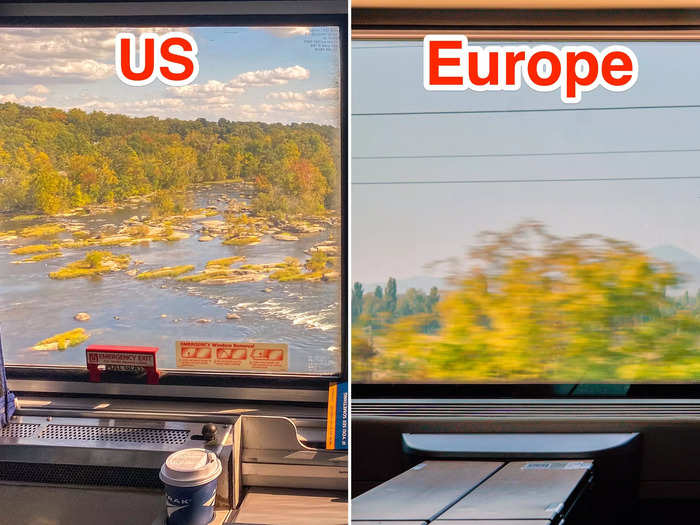
Train speeds vary from the US to Europe.
According to the Washington Post, most Amtrak trains in the US travel between 110 and 145 miles per hour.
Some of the trains in Europe go even faster. According to Trainline, an international travel company for booking train tickets, high-speed trains in Europe can reach up to 200 miles per hour, although they're not all that fast. In most countries I visited, I was able to try out the high-speed InnerCity Express trains.
I traveled at high speeds in Austria, Germany, and Switzerland, and found that the rides were bumpier than I've experienced in the US. I felt more motion sickness on European trains than I have on Amtrak trains, as well. I'm not sure if the higher speeds were responsible for the bumpiness, but my motion sickness made the rides feel even longer.
I've stayed in overnight sleeper cabins in the US and Europe. The trains I experienced in the US were private sleeper cabins, while in Europe, I booked shared rooms with other travelers.
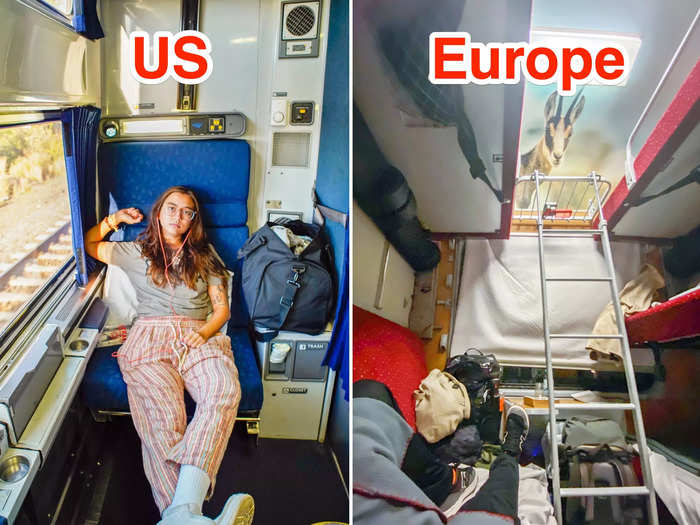
Both European and Amtrak US overnight trains have private sleeper cabins.
When I traveled in sleeper cabins on Amtrak trains, I booked a roomette — a 20-square-foot enclosed space with two beds — and a bedroom— a 45-square-foot space with two beds and a bathroom. Having my own space made me feel more comfortable for each of these 30-hour rides. Amtrak also offers cabins with standard coach seating on overnight rides, but I haven't experienced them.
In Europe, some trains, like the Nightjets I took from Germany to Austria and from Austria to Italy, have shared cabins where travelers can book one bunk in a room for four to six travelers.
Nightjet also offers single bunks for solo travelers, but none were available when I booked my trip. I decided to try a shared cabin since they're not available on Amtrak trains, and found it was too cramped for my comfort and didn't provide me with as much privacy as I'd like.
I also tried the shared seating carriage option and thought it was even more cramped. Next time I'm in Europe and need to travel overnight by train, I'll look for routes with private sleeper cabins.
Tickets for sleeper trains in the US and Europe both include breakfast, but I thought that trains in the US provided larger, more well-rounded meals than in Europe.
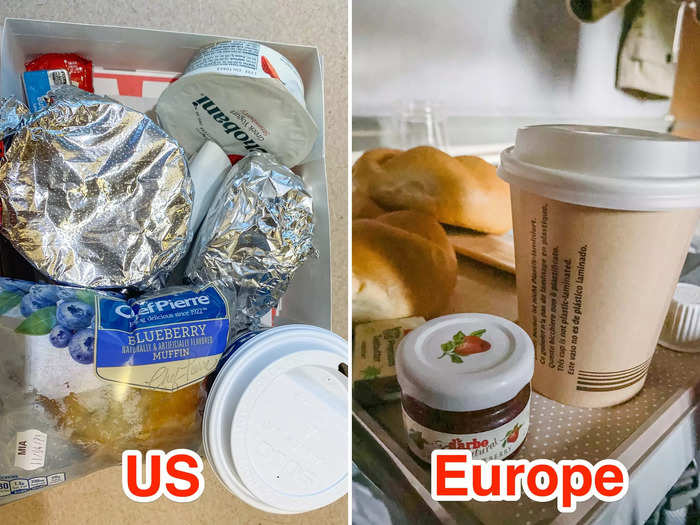
Sleeper cabins I experienced in the US and Europe both included complimentary breakfast.
Each time I traveled overnight on Amtrak trains in roomette or bedroom accommodations, I got the same breakfast — an egg sandwich, a muffin, Greek yogurt, oatmeal, and coffee. I thought it was a little too much food for me, but I was happy to have a balanced breakfast with protein, dairy, and carbs.
When I traveled in a Nightjet sleeper car in Europe, my meal was much simpler — a coffee and two french rolls with butter and jam. While it was enough to fill me up, I thought the European breakfast was less satisfying because it offered only carbs, as well as less flavor than its American counterpart.
I don't think train travel is better in the US or Europe. They're just different.
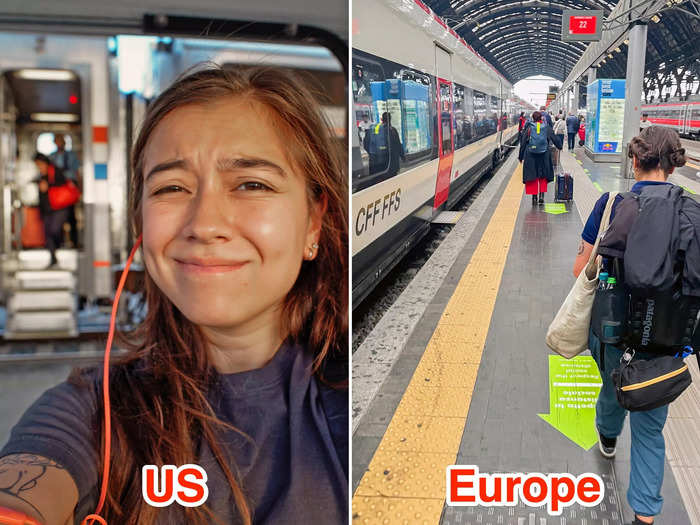
After experiencing many different types of trains in both the US and Europe, I don't think train travel is significantly better or worse in one or the other.
They're just different. Both have strengths and weaknesses, in my opinion.
While the US has an easier boarding process and better breakfast, I also found that European trains seemed to be comfier and have more information about upcoming stops inside the trains, in my experience.
I plan to continue taking trains in the US and Europe to try new routes and accommodations while riding the rails.
Popular Right Now
Popular Keywords
Advertisement